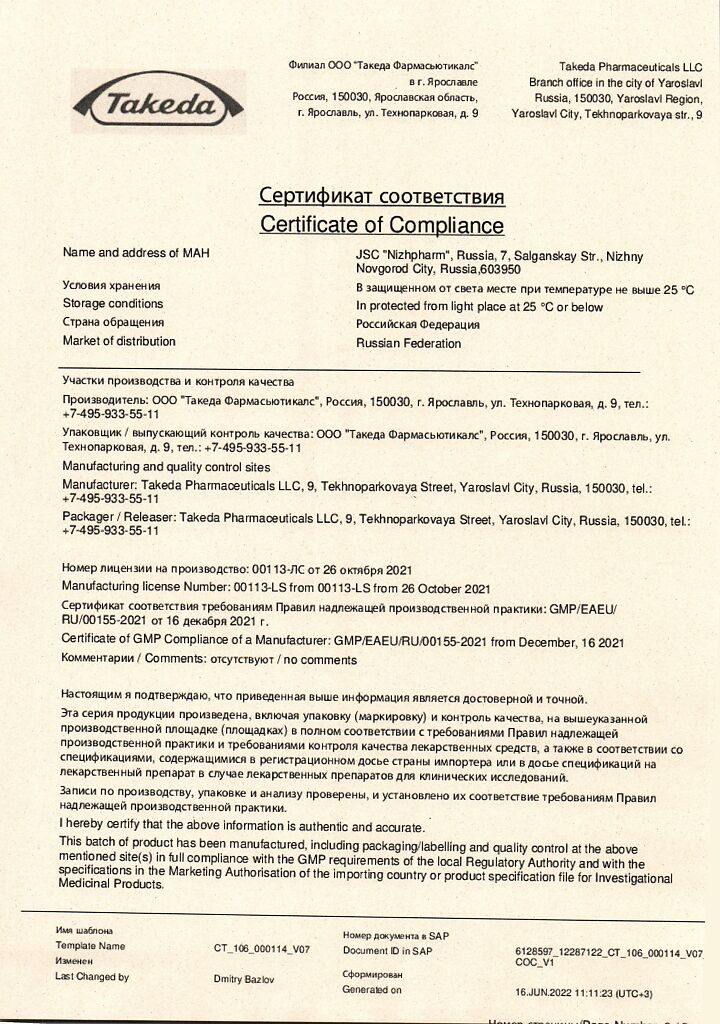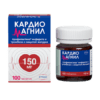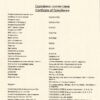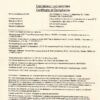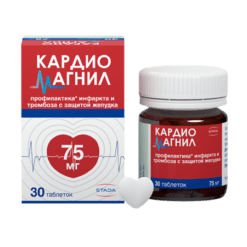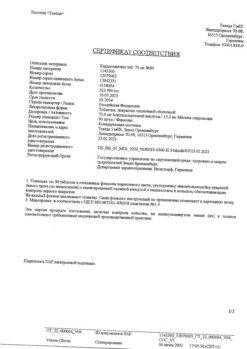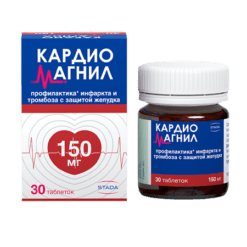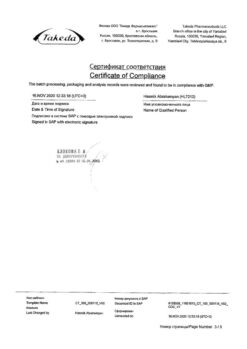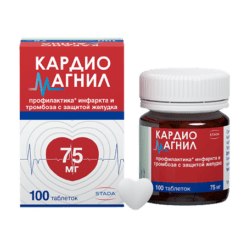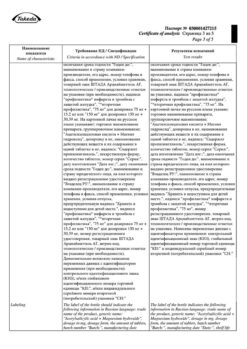No products in the cart.
Cardiomagnil, 150 mg+30.39 mg 100 pcs
€11.61 €10.16
Description
Pharmacotherapeutic group:
Antiplatelet
ATX code: B01AC30
Pharmacological properties
Pharmacodynamics
The mechanism of action of acetylsalicylic acid (ASA) is based on irreversible inhibition of cyclooxygenase (COX-1), resulting in blocked synthesis of thromboxane A2 and suppressed platelet aggregation. It is believed that ASA has other mechanisms to inhibit platelet aggregation, which expands the field of its use in various vascular diseases. ASA also has anti-inflammatory, analgesic and antipyretic effects.
Magnesium hydroxide, which is part of the drug Cardiomagnesil, may help to protect the mucous membrane of the stomach from the effects of acetylsalicylic acid.
Pharmacokinetics
Acetylsalicylic acid
absorption<./i>
Ask is rapidly and completely absorbed from the gastrointestinal tract (GIT) after oral administration. During and after absorption, ASK is converted to its main metabolite, salicylic acid (SA). The maximum concentration of ASA in blood plasma is reached 20 minutes after oral administration, CK – 1-2 hours later. At simultaneous intake with food slows down absorption of ASK without influence on absorption degree.
Bioavailability of ASK is about 70%, but this value varies significantly, because ASK undergoes presystemic hydrolysis (mucosa of gastrointestinal tract, liver) in SC under the action of enzymes. The bioavailability of CK is 80-100%.
Distribution
ASK and CK are largely bound to plasma proteins and rapidly distributed in the body. The degree to which SC binds to plasma proteins depends on the concentration. Salicylic acid penetrates the placenta and is excreted with breast milk.
Metabolism
The main metabolite of ASA is salicylic acid. Salicylic acid is metabolized in the liver to form salicyluric acid, the phenolic glucuronide of salicylic acid, salicyl glucuronide and gentisinic acid.
Evolution
The half-life of ASK is about 15 minutes, because with the participation of enzymes ASK is rapidly hydrolyzed into SC in the intestine, liver and blood plasma. The half-life of CK is about 3 hours, but it can be significantly increased by simultaneous
administration of large doses of ASK (more than 3.0 g) as a result of saturation of enzyme systems.
Salicylic acid and its metabolites are excreted mainly by the kidneys.
Magnesium hydroxide
Intake
Magnesium hydroxide has low absorption and has no systemic action.
Distribution and metabolism
Magnesium hydroxide is not metabolized.
Evolution
Magnesium hydroxide is excreted through the intestine.
Doses of magnesium hydroxide used do not affect the bioavailability of acetylsalicylic acid.
Indications
Indications
– Unstable angina and stable angina;
– Prevention of recurrent myocardial infarction;
– Prevention of recurrent transient ischemic attack (TIA) and recurrent ischemic stroke in patients who previously suffered a cerebrovascular accident;
– Prevention of thrombotic complications after operations and invasive interventions on blood vessels (such as coronary artery bypass surgery, carotid endarterectomy, arteriovenous bypass, angioplasty and stenting of the coronary arteries, carotid angioplasty).
Pharmacological effect
Pharmacological effect
Pharmacotherapeutic group:
Antiplatelet agent
ATX code: В01AC30
Pharmacological properties
Pharmacodynamics
The mechanism of action of acetylsalicylic acid (ASA) is based on the irreversible inhibition of cyclooxygenase (COX-1), as a result of which the synthesis of thromboxane A2 is blocked and platelet aggregation is suppressed. It is believed that ASA has other mechanisms for suppressing platelet aggregation, which expands the scope of its use in various vascular diseases. ASA also has anti-inflammatory, analgesic, and antipyretic effects.
Magnesium hydroxide, which is part of the drug Cardiomagnyl, can help protect the gastric mucosa from the effects of acetylsalicylic acid.
Pharmacokinetics
Asetylsalicylic acid
Suction
After oral administration, ASA is quickly and completely absorbed from the gastrointestinal tract (GIT). During and after absorption, ASA is converted into its main metabolite, salicylic acid (SA). The maximum concentration of ASA in blood plasma is achieved
20 minutes after ingestion, SC – after 1-2 hours. When taken simultaneously with food, there is a slowdown in the absorption of ASA without affecting the degree of absorption.
The bioavailability of ASA is about 70%, but this value fluctuates significantly, since ASA undergoes presystemic hydrolysis (gastrointestinal mucosa, liver) into SA under the action of enzymes. Bioavailability of SA is 80-100%.
Distribution
ASA and SA are largely bound to plasma proteins and are rapidly distributed in the body. The degree of binding of SA to plasma proteins depends on the concentration. Salicylic acid crosses the placenta and is excreted in breast milk.
Metabolism
The main metabolite of ASA is salicylic acid. Salicylic acid is metabolized in the liver to form salicyluric acid, salicylic acid phenolic glucuronide, salicylic glucuronide and gentisic acid.
Removal
The half-life of ASA is about 15 minutes, because with the participation of ASA enzymes, it is quickly hydrolyzed into SA in the intestines, liver and blood plasma. The half-life of SA is about 3 hours, but it can increase significantly with simultaneous
administration of large doses of ASA (more than 3.0 g) as a result of saturation of enzyme systems.
Salicylic acid and its metabolites are excreted primarily by the kidneys.
Magnesium hydroxide
Suction
Magnesium hydroxide has low absorption and does not have a systemic effect.
Distribution and metabolism
Magnesium hydroxide is not metabolized.
Removal
Magnesium hydroxide is excreted through the intestines.
The doses of magnesium hydroxide used do not affect the bioavailability of acetylsalicylic acid.
Special instructions
Special instructions
The drug should be used after a doctor’s prescription.
ASA can provoke bronchospasm, as well as cause attacks of bronchial asthma and other hypersensitivity reactions. Risk factors include a history of bronchial asthma, hay fever, nasal polyposis, chronic
diseases of the respiratory system, as well as allergic reactions to other drugs (for example, skin reactions, itching, urticaria).
ASA can cause bleeding of varying severity during and after surgery. Several days before planned surgery, the risk of bleeding should be assessed in comparison with the risk of ischemic complications in patients taking low doses of ASA. If the risk of bleeding is significant, ASA should be temporarily discontinued.
The combination of ASA with anticoagulants, thrombolytics and antiplatelet drugs is accompanied by an increased risk of bleeding.
ASA in low doses can provoke the development of gout in predisposed patients (those with reduced excretion of uric acid).
The combination of ASA with methotrexate is accompanied by an increased incidence of side effects from the hematopoietic organs.
High doses of ASA have a hypoglycemic effect, which must be kept in mind when prescribing it to patients with diabetes mellitus receiving oral hypoglycemic agents and insulin.
When using systemic glucocorticosteroids (GCS) and salicylates in combination, it should be remembered that during treatment the concentration of salicylates in the blood is reduced, and after discontinuation of systemic glucocorticosteroids (GCS), an overdose of salicylates is possible.
Metamizole and some NSAIDs (including ibuprofen, naproxen) can weaken the inhibitory effect of ASA on platelet aggregation. Patients taking ASA and planning to take metamizole or an NSAID should discuss this with their doctor (see
section “Interaction with other drugs”).
Exceeding the dose of ASA above the recommended therapeutic doses is associated with the risk of gastrointestinal bleeding.
When taking low doses of ASA for a long time as aggregative therapy, caution must be exercised in elderly patients due to the risk of gastrointestinal bleeding.
When taking ASA simultaneously with alcohol, there is an increased risk of damage to the mucous membrane of the gastrointestinal tract and prolongation of bleeding time.
In patients with impaired renal function or in patients with circulatory disorders resulting from damage to the renal arteries, chronic heart failure, hypovolemia, major surgery, sepsis or
In cases of massive bleeding, the drug Cardiomagnyl should be used with caution, since ASA may increase the risk of developing acute renal failure and impaired renal function.
In severe forms of glucose-6-phosphate dehydrogenase deficiency, ASA can cause hemolysis and hemolytic anemia. Factors that may increase the risk of hemolysis include fever, acute infections and high doses of the drug.
Medicines containing ASA should not be used in children and adolescents to treat viral infections with or without fever without consulting a doctor. There is a risk for certain viral illnesses, particularly influenza A, influenza B and chicken pox
the development of Reye’s syndrome, a very rare but life-threatening disease that requires immediate medical intervention. The risk may be increased if ASA is used as concomitant therapy, but there is no causal relationship
was confirmed. Uncontrollable vomiting in these diseases may be a symptom of Reye’s syndrome.
When using the drug independently, you should not exceed the maximum duration and recommended doses. If there is no improvement or if the symptoms of the disease worsen, it is recommended to consult a doctor.
Impact on the ability to drive vehicles and machinery
During treatment with ASA drugs, care must be taken when driving vehicles and engaging in potentially hazardous activities that require increased concentration and speed of psychomotor reactions.
Active ingredient
Active ingredient
Acetylsalicylic acid, [Magnesium hydroxide]
Composition
Composition
One tablet contains
Active ingredients:
Acetylsalicylic acid……………………………………75 mg / 150 mg
Magnesium hydroxide……………………………………………………….15.2 mg / 30.39 mg
Excipients: corn starch, microcrystalline cellulose, magnesium stearate, potato starch; shell: hypromellose (methylhydroxypropylcellulose 15), propylene glycol, talc.
Pregnancy
Pregnancy
Pregnancy
Animal studies have demonstrated the reproductive toxicity of acetylsalicylic acid. The use of large doses of salicylates in the first 3 months of pregnancy is associated with an increased incidence of fetal defects. In the first trimester of pregnancy, the use of drugs containing acetylsalicylic acid is contraindicated. In the second trimester of pregnancy up to 20 weeks, salicylates can be prescribed only taking into account a strict assessment of risks and benefits. The use of NSAIDs is contraindicated for women from the 20th week of pregnancy due to the possible development of oligohydramnios and/or kidney pathology in newborns (neonatal renal dysfunction).
In the last trimester of pregnancy, salicylates in high doses (more than 300 mg/day) cause inhibition of labor, premature closure of the ductus arteriosus in the fetus, increased bleeding in the mother and fetus, and administration immediately before birth can cause intracranial hemorrhage, especially in premature infants.
Breastfeeding period
Salicylates and their metabolites pass into breast milk in small quantities.
The available clinical data are insufficient to establish the possibility or impossibility of using the drug during breastfeeding. Before prescribing acetylsalicylic acid during breastfeeding, the potential benefit of drug therapy should be assessed against the potential risk for infants.
Contraindications
Contraindications
Hypersensitivity to ASA, excipients of the drug and other NSAIDs, cerebral hemorrhage; tendency to bleeding (vitamin K deficiency, thrombocytopenia, hemorrhagic diathesis); bronchial asthma induced by taking salicylates and NSAIDs; complete or incomplete combination of bronchial asthma, recurrent polyposis of the nose and paranasal sinuses and intolerance to acetylsalicylic acid or other NSAIDs, including COX-2 inhibitors (including a history); erosive and ulcerative lesions of the gastrointestinal tract (in the acute phase); gastrointestinal bleeding; severe liver dysfunction; severe renal failure (creatinine clearance less than 30 ml/min); chronic heart failure of functional class III-IV according to the NYHA classification; pregnancy (1st trimester, 2nd trimester at more than 20 weeks and 3rd trimester of pregnancy); breastfeeding period; deficiency of glucose-6-phosphate dehydrogenase; simultaneous use with methotrexate (more than 15 mg per week); children under 18 years of age.
With caution
For gout, hyperuricemia, history of gastrointestinal ulcers or gastrointestinal bleeding, impaired liver function, impaired renal function, bronchial asthma, hay fever, nasal polyposis, hypersensitivity to analgesics, anti-inflammatory drugs, anti-rheumatic drugs, as well as allergic reactions to other substances, with proposed surgery (including minor ones, for example, tooth extraction); in the second trimester of pregnancy up to 20 weeks.
Caution should be exercised during concomitant therapy with the following drugs:
methotrexate at a dose of less than 15 mg per week; anticoagulant, thrombolytic or other antiplatelet agents; metamizole and NSAIDs (including ibuprofen, naproxen), digoxin, oral hypoglycemic agents (sulfonylurea derivatives) and insulin, valproic acid, ethanol, selective serotonin reuptake inhibitors).
If you have one of the diseases listed above, you should consult your doctor before using the drug.
Side Effects
Side Effects
Criteria for assessing the frequency of adverse reactions: very often (≥1/10), often (≥1/100, <1/10), infrequently (≥1/1000, <1/100), rarely (≥1/10000, <1/1000); very rare (< 1/10000); frequency unknown – cannot be estimated from available data.
Blood and lymphatic system disorders
Uncommon: iron deficiency anemia (associated with bleeding); rarely: hemorrhagic anemia; frequency unknown: hemolysis, hemolytic anemia (associated with severe forms of glucose-6-phosphate dehydrogenase deficiency).
Interaction
Interaction
The simultaneous use of the drug Cardiomagnyl with methotrexate can lead to an increase in the hematological toxicity of methotrexate by reducing renal clearance and displacing it from plasma proteins. Use with methotrexate at a dose of more than 15 mg per week is contraindicated. Use with methotrexate at a dose of less than 15 mg per week is possible with extreme caution if the benefit to the patient outweighs the risk.
When the drug is used simultaneously with other NSAIDs containing salicylates in large doses, there is an increased risk of ulcerogenic effects and gastrointestinal bleeding.
When used simultaneously, ASA enhances the effect of the following drugs:
• methotrexate by reducing renal clearance and displacing it from protein binding
• heparin and indirect anticoagulants due to disruption of platelet function and displacement of indirect anticoagulants from protein binding
• thrombolytic and antiplatelet and anticoagulant drugs
• digoxin due to decreased renal excretion
• hypoglycemic agents for oral administration (sulfonylurea derivatives) and insulin due to the hypoglycemic properties of ASA itself in high doses and displacing sulfonylurea derivatives from association with blood plasma proteins
• valproic acid due to its displacement from binding with proteins
When used simultaneously (within one day) with metamizole and some NSAIDs (including ibuprofen and naproxen), antagonism is noted against the irreversible inhibition of platelet function caused by the action of ASA.
The clinical significance of this effect is unknown. The combination of ASA with metamizole or NSAIDs (including ibuprofen or naproxen) is not recommended in patients at high risk of cardiovascular disease due to a possible decrease in the cardioprotective effects of ASA.
When taking ASA in combination with ethanol (alcohol), there is an increased risk of damage to the mucous membrane of the gastrointestinal tract and prolongation of bleeding time as a result of the mutual enhancement of the effects of ASA and ethanol.
ASA weakens the effect of uricosuric drugs (benzbromarone) due to competitive tubular elimination of uric acid.
By enhancing the elimination of salicylates, systemic glucocorticosteroids (GCS) weaken their effect.
Antacids and cholestyramine reduce the absorption of the drug.
Concomitant use of ASA with selective serotonin reuptake inhibitors may lead to an increased risk of upper gastrointestinal bleeding due to a possible synergistic effect.
With the simultaneous use of diuretics with ASA in high doses, a decrease in glomerular filtration rate is observed as a result of a decrease in the synthesis of prostaglandins in the kidneys.
When angiotensin-converting enzyme (ACE) inhibitors are combined with high doses of ASA, a decrease in glomerular filtration rate is observed as a result of inhibition of prostaglandins, which have a vasodilatory effect. In addition, there is a weakening of the antihypertensive effect of ACE inhibitors.
If you are taking the above or other medications (including over-the-counter medications), consult your doctor before using this medication.
Overdose
Overdose
Symptoms of moderate overdose
Nausea, vomiting, tinnitus, hearing loss, dizziness, confusion.
Treatment
Rinse the stomach, take activated charcoal. Treatment is symptomatic.
Symptoms of severe overdose
Fever, hyperventilation, ketoacidosis, respiratory alkalosis, coma, cardiovascular and respiratory failure, severe hypoglycemia.
Treatment
Immediate hospitalization in specialized departments for emergency treatment – gastric lavage, determination of acid-base balance, alkaline and forced alkaline diuresis, hemodialysis, administration of solutions, activated charcoal, symptomatic therapy. When carrying out alkaline diuresis, it is necessary to achieve pH values between 7.5 and 8. Forced alkaline diuresis should be carried out when the concentration of salicylates in plasma is more than 500 mg/l (3.6 mmol/l) in adults and 300 mg/l (2.2 mmol/l) in children.
In case of overdose, consult a doctor immediately.
Storage conditions
Storage conditions
The drug should be stored in a dry place, protected from light and out of reach of children, at a temperature not exceeding 25°C.
Shelf life
Shelf life
3 years. Do not use after the expiration date.
Manufacturer
Manufacturer
Takeda Pharmaceuticals LLC, Russia
Additional information
| Shelf life | 3 years. Do not use after the expiration date. |
|---|---|
| Conditions of storage | The drug should be stored in a dry place, protected from light and out of reach of children at a temperature not exceeding 25 ° C |
| Manufacturer | Takeda Pharmaceuticals LLC, Russia |
| Medication form | pills |
| Brand | Takeda Pharmaceuticals LLC |
Other forms…
Related products
Buy Cardiomagnil, 150 mg+30.39 mg 100 pcs with delivery to USA, UK, Europe and over 120 other countries.



